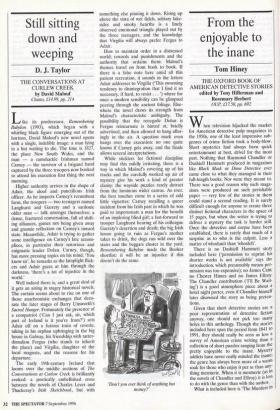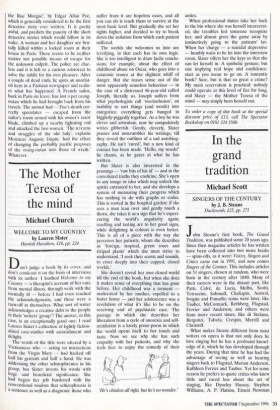From the enjoyable to the inane
Tom Hiney
THE OXFORD BOOK OF AMERICAN DETECTIVE STORIES edited by Tony Hillerman and Rosemary Herbert OUP, £17.50, pp. 692
When television hijacked the market for American detective pulp magazines in the 1950s, one of the least impressive sub- genres of crime fiction took a body-blow. Short mysteries had always been quick entertainment at best, drivel for the most part. Nothing that Raymond Chandler or Dashiell Hammett produced in magazines like Black Mask or Dime Detective ever came close to what they managed in their full-length books. Nor were they meant to. There was a good reason why such maga- zines were produced on such perishable paper — very few of the stories in them could stand a second reading. It is surely difficult enough for anyone to create three distinct fictional characters in the space of 15 pages, but when the writer is trying to deliver a mystery the task is harder still. Once the detective and corpse have been established, there is rarely that much of a surprise as to who is the culprit. Less a matter of whodunit than `whosleff.
There is no Dashiell Hammett story included here ('permission to reprint his shorter works is not available' says the introduction, which presumably means per- mission was too expensive); no James Cain; no Chester Himes and no James Ellroy. The Chandler contribution (T11 Be Wait- ing') is a good atmosphere piece about a hotel night porter, even if Chandler himself later disowned the story as being preten- tious.
Given that short detective stories are a poor representation of detective fiction anyway, one should not pick too many holes in this anthology. Though the stories included here span the period from 1841 to 1991, they should really be seen as less a survey of American crime writing than a collection of short puzzles ranging from the pretty enjoyable to the inane. Mystery addicts have never really minded the inane; the genre has always been more of a warm soak for those who enjoy it per se than any- thing mesmeric. When it is mesmeric (as in the novels of Chandler and Ellroy) it is less to do with the genre than with the author. What is included here is 'The Murders la the Rue Morgue', by Edgar Allan Poe, which is generally considered to be the first detective story ever written. It is pretty awful, and predicts the paucity of the short detective stories which would follow in its wake. A woman and her daughter are bru- tally killed within a locked room at their house in Paris. There seems to be neither motive nor possible means of escape for the unknown culprit. The police are clue- less and it is left to a curious aristocrat to solve the riddle for his own pleasure. After a couple of dead ends, he spots an unrelat- ed item in a Parisian newspaper and realis- es what has happened. A French sailor, back in Paris on leave, has lost a pet orang- outan which he had brought back from his travels, The animal had — Poe's sleuth cor- rectly speculates — escaped from the sailor's room armed with his owner's razor blade, climbed up a nearby lightning rod and attacked the two women. The screams and struggles of the old lady', explains Monsieur Auguste Dupin, had the effect of changing the probably pacific purposes of the orang-outan into those of wrath.' Whatever.



























































 Previous page
Previous page